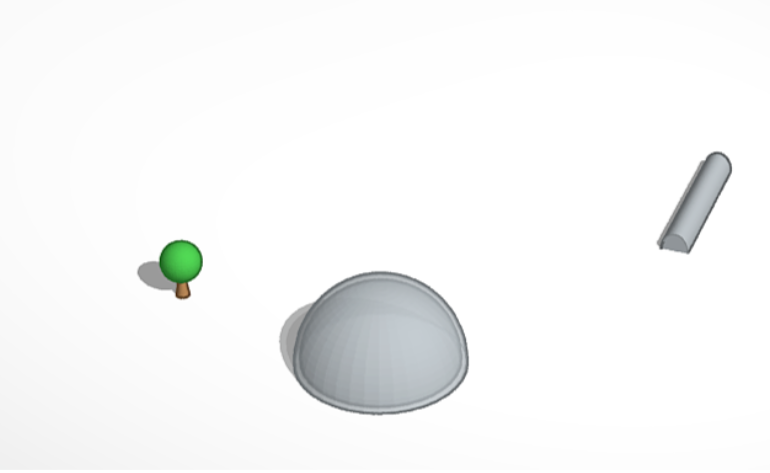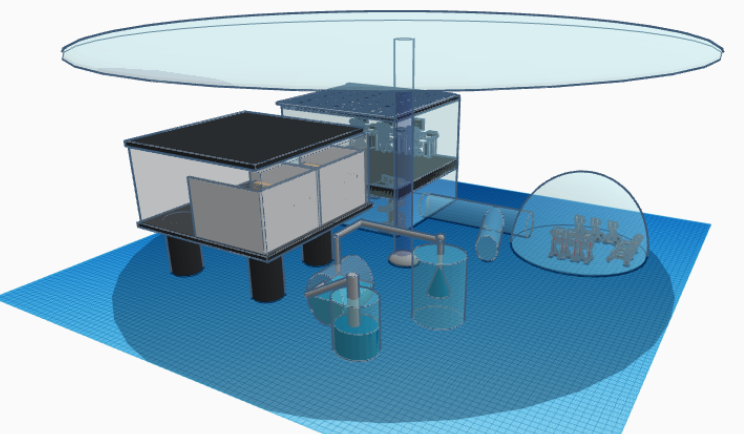Moon Camp Explorers Gallery 2021-2022
In Moon Camp Explorers each team’s mission is to 3D design a complete Moon Camp using Tinkercad. They also have to explain how they will use local resources, protect astronauts from the dangerous of space and describe the living and working facilities.
Team: Pπ LUNAR CAMPAMENT
IES Bahía de Almería Almería Spain 14 5 / 2
External link for 3d
|
Project description
There will live 50 astronauts. The camp consists of two domes closed to the outside (made of rocket-like glass) collocated over the Nobile crater. The first dome, which has contact with the outside of the Moon, has plantations inside like a greenhouse. This dome has grids that contact with the second dome, where the rooms and the different installations of the camp are. These grids are only open during the day to provide oxygen, and close at night. In addition, the domes have an air purifier, which controls the levels of O2 and CO2 and provides to each dome the quantities they need to make an “artificial atmosphere”. On the inside of the inner dome we can find the rooms for the astronauts, an elevator leading to the interior of the moon for mining and investigating, a communication room and an advanced farm with animals for consumption. For finishing, on the outside of the domes there are two other installations: |
||||
|
Where do you want to build your Moon Camp?
Inside the Nobile crater Why did you choose this location?
We chose this location because it is in the South Pole of the Moon which is considered the best place to install it. When the sunlight enters, the sun’s rays strike obliquely so radiation won’t be a big problem. We can provide solar energy from the top of the mountains nearby which are illuminated during long periods of time. Near this location we can also find frozen water from craters in the zone such as Shackleton crater. Furthermore, it is considered a good place for landing spaceships to transport to the Earth and it is big enough (73km diameter). Before sending the astronauts we have to send the spaceships with the builders of the base. It’s too expensive to send materials from the Earth to the Moon , so we ruled out this option. Buildings should have thick enough walls to protect the astronauts from radiation. The lunar concrete (normal concrete but replacing the water with the liquid sulfur) is the best option for this objective. To build concrete structures we can use human urine, which is easy to get , in large quantities and without the need to transportt it from Earth. . Other materials that we would use are regolith, basalt fibers, lunar dust,… How do you plan to build your Mooncamp? Which materials will you use?
Before sending the astronauts we have to send the spaceships with the builders of the base. It’s too expensive to send materials from the Earth to the Moon , so we ruled out this option. Buildings should have thick enough walls to protect the astronauts from radiation. The lunar concrete (normal concrete but replacing the water with the liquid sulfur) is the best option for this objective. To build concrete structures we can use human urine, which is easy to get , in large quantities and without the need to transport it from Earth. Other materials that we would use are regolit, |
||||
|
Water
|
Food
|
Electricity
|
Air
|
Protection
|
|
It’s very expensive to transport water from Earth to the Moon, so the best option is to thaw the ice on it. Although as there are studies that deny the existence of this ice, as another alternative we can obtain water with hydrogen and oxygen from the surface of the moon. |
A permanent settlement will likely include greenhouses to grow vegetables and fruit for the settlers. Growing crops on the Moon faces many difficult challenges due to the long lunar night, extreme temperature variations, radiation exposure, lack of water and elements or the absence of insects for pollination. Various solutions have been proposed for long periods of darkness, including the use of artificial light to maintain plants at night, but the use of electric lighting to compensate for the absence of natural light could be difficult, since one hectare of cultivation on the Earth enjoys a peak of 10 megawatts of solar energy at noon, an amount of energy that is difficult to obtain. We could use the fast-growing crops, which could be started as seedlings in artificial light and have grown sufficiently to survive the end of a lunar day. |
We can get energy through solar panels placed on mountains which almost always receive sun energy, and with this energy we can generate light if it is necessary too. Furthermore, we can burn the composting obtained in the recycling plant. |
We can get oxygen in the Moon, but it is situated in the center of the rocks, these rocks are called regolith. |
To protect the camp it is suggested that the base be protected by artificial magnetic fields to provide protection from radiation. The domes would also be covered with regolith to protect it against meteorite impacts. |
|
Describe a day on the Moon for one of your Moon Camp astronauts
I’m Juanjo, the control captain of Pπ Lunar Campament. Today I wake up at 7:00 in the morning. I leave my room and go to the dining room where some of my workmates are having breakfast so I join them and ask if there are any news. Afterwards, I clean up myself and get dressed with the uniform. First of all, I go down the elevator to the control room for checking the level of the gasses and see if there’s any new message from the Earth. Then, I walk to the greenhouse where I supervise the work of the agricultors and the food reserves. All the information that I have been obtaining, I’ve been writing it in my tablet which is connected to a programme where I collect the informs of each week. Later, I have lunch in the dining room again and rest for half an hour in my room. After this, I put my astronaut uniform to go to the space station outside. One of the spaceships has a failure but it is under control. The mechanic team come to repair it and they finally fix it. For finishing my general revision, I go to the mines and then i have a meeting with the other captains of the camp. At the end of the day, I have dinner and go to sleep to my room at 11:00 pm. |
||||







